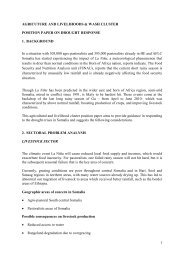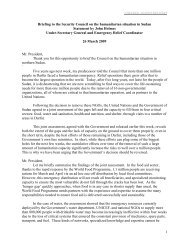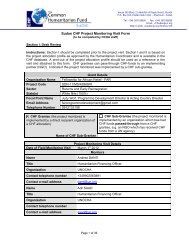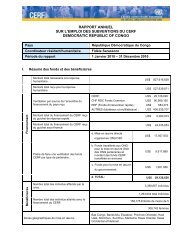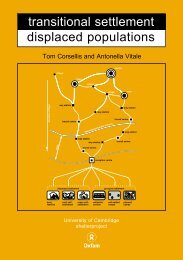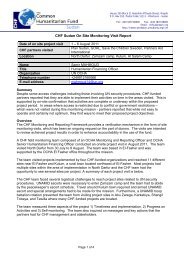Shelter - NFI SPHERE - OCHANet
Shelter - NFI SPHERE - OCHANet
Shelter - NFI SPHERE - OCHANet
Create successful ePaper yourself
Turn your PDF publications into a flip-book with our unique Google optimized e-Paper software.
Minimum Standards in <strong>Shelter</strong>, Settlement and Non-Food Items<br />
<strong>Shelter</strong> and settlement standard 3: covered<br />
living space<br />
People have sufficient covered space to provide dignified<br />
accommodation. Essential household activities can be satisfactorily<br />
undertaken, and livelihood support activities can be pursued as required.<br />
Key indicators (to be read in conjunction with the guidance notes)<br />
● The initial covered floor area per person is at least 3.5m 2 (see<br />
guidance notes 1-3).<br />
● The covered area enables safe separation and privacy between the<br />
sexes, between different age groups and between separate families<br />
within a given household as required (see guidance notes 4-5).<br />
● Essential household activities can be carried out within the shelter<br />
(see guidance notes 6 and 8).<br />
● Key livelihood support activities are accommodated where possible<br />
(see guidance notes 7-8).<br />
Guidance notes<br />
1. Climate and context: in cold climates, household activities typically take<br />
place within the covered area and disaster-affected people may spend<br />
substantial time inside to ensure adequate thermal comfort. In urban<br />
settings, household activities typically occur within the covered area as<br />
there is usually less adjacent external space that can be used. In hot and<br />
humid climates, space to allow for additional air circulation is required to<br />
maintain a healthy environment. A covered floor area in excess of 3.5m 2<br />
per person will often be required to meet these considerations. The floor to<br />
ceiling height is also a key factor, with greater height being preferable in hot<br />
and humid climates to aid air circulation, while a lower height is preferable<br />
in cold climates to minimise the internal volume that requires heating. In<br />
warmer climates, shaded external space adjacent to the shelter can be<br />
established for food preparation, cooking and sleeping.<br />
<strong>Shelter</strong><br />
219




